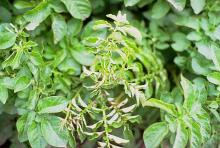By P. B. Hamm and C. M. Ocamb
See:
Potato (Solanum tuberosum) - Purple Top
Cause The aster yellows phytoplasma, transmitted by the aster leafhopper and other leafhoppers, and carried in infected tubers. The disease is found principally in eastern Oregon, Washington, and Idaho. In the Hermiston, OR area, leafhoppers enter potatoes when surrounding desert vegetation dries up. The main disease sources are infected potato seed, ladino clover, and perennial weeds. Aster yellows in not commonly found and cannot be separated from Purple Top without laboratory testing.
Symptoms Tip leaves begin to roll up, and plants develop an off-green or yellowish cast. Aerial tubers form, and leaves and stems have a purplish cast. Interveinal leaf tissue may die, giving stems and leaf ribs a more prominent appearance. Plants may wilt quickly and fall over. Tubers are smaller, soft, and flabby. Some plants have numerous small tubers; others develop one or two giant, rough tubers. Stem girdling by Rhizoctonia and/or current season infection by potato leafroll virus or zebra chip may cause similar symptoms.
Cultural control
- Plant only certified seed potatoes.
Chemical control Timing of insecticide use is very important. Using products in mid-May to early June, as leaf hopper populations are increasing, will substantially reduce levels of infection. For materials, rates, and procedures, consult the PNW Insect Management Handbook.

